The ESTER project
Evolution STEllaire en Rotation
The ambition of this project is to set out a multi-dimensional
stellar evolution code, which fully takes into account the effects
of rotation, tidal potential, large-scale magnetic fields, etc. in a
self-consistent way. The difficult, but important point is that stars
affected by large-scale effects like rotation or tidal interaction, are
spheroidal and are never in hydrostatic equilibrium. They are pervaded by
flows everywhere, even in the stably stratified radiative regions. These
flows are essentially convective flows in thermally unstable regions
(convection zones) and baroclinic flows in the radiative regions. These
latter flows are grosso modo a differential rotation and a meridional
circulation, with likely some small-scale turbulence. A primary motivation
to include more than one dimension in models is to be able to deal with
strong effects like fast rotation. Radiative regions of non-rotating
stars experience very little mixing (only due to microscopic phenomena),
but rotation induces flows and therefore some mixing, well-known as
"rotational mixing". This is a key feature of the evolution of rotating
stars. Besides, these stars also oscillate, and astronomers would like
to get from the oscillation frequencies some good constraints on the
structure of these stars. The foregoing reasons and many others motivated
us to construct multi-dimensional models of rotating stars that will
enlight us on the numerous questions we are wondering about...
The project was started Michel Rieutord. It has been strongly
supported by the Programme National de Physique Stellaire (PNPS),
the Action spécifique pour la Simulation Numérique en
Astrophysique (ASSNA), and the CNRS in general with a two-year post-doc
position in 2005-2007 given to Francisco Espinosa Lara.
Some News
The ESTER project as such was first funded by ANR in 2009-2014. The
main result of this first part was the release of steady models for
main sequence early-type stars (mass above 2 solar masses).
The ESTER project has been next funded under the ANR-ESRR project
(Evolution Stellaire en Rotation Rapide 1/2017--1/2021), which was
focusing on secular time evolution of stars and applications to the
interpretation of interferometry and asteroseismology data.
The ESTER project has then been supported by the ANR-MASSIF project (2022-2025)
to futher develop its applications to massive stars and their
observations in interferometry.
The ESTER project is now part of the 4D-STAR
project (2023-2029), funded by an ERC Synergy grant, which will
make it evolve to deliver evolutionary models of stars including the
three dimensions of space.
The ESTER project is also contributing to the PLATO mission by
delivrering the first multi-dimensional models of solar-type stars.
ESTER Workshops
- The first ESTER Workshop: 10-11-12 June 2014 in Toulouse: see the web
page for all the details of the workshop.
- Kick-off meeting of the ANR-ESRR project: 2-3 March 2017 in Toulouse.
A short summary of the meeting here.
Talks have been given by:
- Michel Rieutord
Le point sur les modeles ESTER et les challenges du projets
- Bertrand Putigny
Les aspects 'Domain specific Language' du projet ESTER
- Daniel Reese
Les derniers developpements du code TOP pour l'asterosismologie des
étoiles en rotation rapide
- Damien Gagnier
Initial conditions of early type stars reaching critical rotation during the
main sequence"
- Armando Domiciano de Souza
L'interprétation des données d'interférométrie stellaire
- Kévin Bouchaud
Quelques notes sur la reconstruction du spectre continu de l'étoile
theta Sco
The ESTER Code
At the moment (August 2024), the ESTER code
exists in two versions: 1/ the one computing steady states of an
isolated early-type star (mass larger than 2 solar masses) on the main
sequence ('master' branch on github), 2/ the one computing the time
evolution of a 2D-model of an isolated early-type star (mass larger than
2 solar masses) on the main sequence ('evolution' branch on github) . The
only convective region computed as such is the core where isentropy is
assumed. It provides the user with solutions of the partial differential
equations, for the pressure, density, temperature, angular velocity
and meridional velocity for the whole volume. The angular velocity
(differential rotation) and meridional circulation are computed
consistently with the structure as a result of the driving by the
baroclinic torque.
In the evolutionary version, diffusion of hydrogen and helium are
included. Please refer to Mombarg et al. (2023,2024) for more details.
Input parameters include the mass of the star, its equatorial
angular velocity scaled by the critical one, the mass-fraction of
hydrogen in the core. Opacity may be computed either analytically
from Kramers-like formulae or from OPAL tables (Grevesse and Noels 1993
mixture), or a smoother interpolation from Houdek. Same as for the EOS
which can be chosen between analytics (ideal gas+ radiation) and OPAL
tables. Other parameters control the numerics.
The code uses spectral methods, both radially and horizontally, with
spherical harmonics and Chebyshev polynomials. The iterations follow
Newton's algorithm.
The code is object-oriented, written in C++; a python suite allows
an easy visualization of the results. While running, Python graphs are
displayed to show the evolution of iterations.
The code is a public code under GNU General Public License. Its first
public version was hosted on the web as a Google-code and has now been
moved to github at
ESTER. Please refer
to the Wiki pages for the installation.
Inspired by our colleagues developing the Pencil Code, we, the
ESTER-project community, ask that in publications and presentations
the use of the code (or parts of it) be acknowledged with reference
to the web site http://userpages.irap.omp.eu/~mrieutord/ESTER.html or
(equivalently) to http://ester-project.github.io/ester/. As a courtesy
to people involved in the development of the program, we suggest to
give appropriate reference to one or several of the following papers
(listed here in temporal order):
- Espinosa Lara F. and Rieutord M.
(2007), ``The dynamics of a
fully radiative rapidly rotating star enclosed within a spherical box",
in Astron. Astrophys., vol. 470, p. 1013-1022
- Rieutord M. and Espinosa Lara F. (2009),
``On the dynamics of a radiative rapidly rotating star", in Comm.
Asterosismology, vol. 158., pp.~99-103
- Rieutord M. and Espinosa Lara F. (2013),
``Ab initio modelling of steady rotating stars", in Seismology
for studies of stellar rotation and convection, Edts Goupil et al.,
Lecture Notes in Physics, vol. 865, p. 49, Springer
- Espinosa Lara F. and Rieutord M.
(2013), ``Self-consistent 2D models of fast rotating early-type stars",
in Astron. Astrophys., vol. 552, A35
- Rieutord M., Espinosa Lara F. and Putigny
B. (2016), ``An
algorithm for computing the 2D structure of fast rotating stars",
in J. Computational Phys.., vol. 318, 277-304 pdf
- Zorec J., Rieutord M., Espinosa Lara F., Frémat
Y., Domiciano de Souza A. and Royer F. (2017), ``Gravity
darkening in stars with surface differential rotation",
in Astron. Astrophys., vol. 606, A32, pdf
- Domiciano de Souza A., Bouchaud K.,
Rieutord M., Espinosa Lara F. and Putigny B. (2018),
``The evolved fast rotator Sargas Stellar parameters and
evolutionary status from VLTI/PIONIER and VLT/UVES",
in Astron. Astrophys., vol. 619, A167 pdf
- Gagnier D., Rieutord M., Charbonnel C.,
Putigny B. and Espinosa Lara F. (2019), ``Critical angular velocity and
anisotropic mass loss of rotating stars with radiation-driven winds",
in Astron. Astrophys., vol. 625, A88
pdf
- Gagnier D., Rieutord M., Charbonnel C.,
Putigny B. and Espinosa Lara F. (2019), ``Evolution of rotation in
rapidly rotating early-type stars during the main sequence with 2D
models", in Astron. Astrophys., vol. 625, A89
pdf
- Bouchaud K., Domiciano de Souza A., Rieutord
M.,, Reese D. and Kervella P. (2020), ``A realistic
two-dimensional model of Altair", in Astron. Astrophys., vol.
633, A78
pdf
- Reese, D. R.; Mirouh, G. M.; Espinosa Lara, F.;
Rieutord, M.; Putigny, B. (2021), ``Oscillations of 2D ESTER models. I.
The adiabatic case", in Astron. Astrophys., vol. 645, A46 pdf
- Lazzarotto A., Hui Bon Hoa A. and Rieutord M.
(2023) ``Photometric determination of rotation axis inclination, rotation rate, and mass of rapidly rotating intermediate-mass stars", in
Astron. Astrophys., vol. 676, A50 pdf
- Mombarg J., Rieutord M. and Espinosa Lara F. (2023)
``The first two-dimensional stellar structure and evolution models of
rotating stars.
Calibration to β Cephei pulsator HD192575", in
Astron. Astrophys., vol. 677, L5 pdf
- Mombarg J. S. G., Rieutord M. and Espinosa Lara F.
(2024), `` A two-dimensional perspective of the rotational evolution of
rapidly rotating intermediate-mass stars. Implications for the formation
of single Be stars", in Astron. Astrophys., vol. 683, A94
pdf
Some Results
The history of modelling rotating stars in two-dimensions can be found
here:
Modeling rapidly rotating stars in Proceedings of SF2A Annual meeting
, p. 501-506
A first investigation of the baroclinic flows in stars:
Rieutord M. (2006),
The dynamics of the radiative envelope of rapidly rotating stars. I. A
spherical Boussinesq model, ref. Astron. Astrophys., vol. 451,
p. 1025-1036
A first "realistic" model of a completely radiative star
encapsulated in bounding sphere may be found in Espinosa
Lara F. and Rieutord M. (2007),
The dynamics of a fully radiative rapidly rotating star enclosed within a
spherical box, ref. Astron. Astrophys., vol. 470, p. 1013-1022
The same but now with a spheroidal boundary which spouses an
isobar surface; in Rieutord and Espinosa Lara
(2009),
On the dynamics of a radiative rapidly rotating star, in Comm.
Asterosismology, vol. 158., pp.~99-103
We show here how the gravity darkening (i.e. the latitude variation
of the surface brightness) can be modelled by a single parameter (the
ratio ω of actual rotation to the critical one) instead
of two in previous models (ω and β an exponent,
controlling the relation between effective temperature and effective
gravity); see Espinosa Lara and Rieutord (2011),
Gravity darkening in rotating stars.
The foregoing approach
is called the omega-model or ω-model, and has been
detailed in the proceedings Rieutord (2016) Physical
processes leading to surface inhomogeneities: the case of rotation
in Lecture Notes in Physics, vol. 914, p. 101-125
The preceding results have been extended to binary stars and it was
shown in passing that the old result of Lucy (1967) that gravity
darkening exponent in low-mass stars is β=0.08, cannot be used to
model actual gravity darkening on stars with variable surface gravity.
This exponent is only valid for spherically symmetric models and comes
from the surface opacity law. See Espinosa Lara and Rieutord
(2012),
Gravity darkening in binary stars.
A synthesis of the results dating October 2011 may be visualized in
this pdf presentation given by F. Espinosa Lara at Santa Barbara
conference on Asteroseismology KITP
Conference
A first detailed account on the ESTER code: the physics of the
model, its mathematical description, its numerical technique and the
first results. These models give the characteristics of stars with mass
in the range 2 to 20 solar masses, rotating up to 98% of the break-up
velocities. These models describe steady-state solutions of the 2D
stellar structure solution including for the first time a
self-consistent determination of the differential rotation and the
associated meridian circulations; see
Rieutord and Espinosa Lara (2012),
Ab initio modelling of steady rotating star in
Seismology for studies of stellar rotation and
convection, Edts Goupil et al., Lecture Notes in Physics,
vol. 835, p. 49, Springer.
and Espinosa Lara and Rieutord (2013), Self-consistent
2D-models of fast rotating early-type stars, in Astron. Astrophys.,
vol. 552, A35
A detailed presentation of the ESTER code, with its numerical
performance (spectral convergence for instance) may be found in Rieutord et
al. (2016) An
algorithm for computing the 2D structure of fast rotating stars,
in J. Computational Phys.., vol. 318, 277-304.
ESTER has been used to model the evolution of the rotation of massive
stars. Such stars indeed lose mass and therefore angular momentum since
they rotate. This investigation was realized by Damien Gagnier during
his PhD thesis and is detailed in 2 papers Gagnier et al. (2019a) Critical
angular velocity and
anisotropic mass loss of rotating stars with radiation-driven winds
and Gagnier et al. (2019b) Evolution
of rotation in
rapidly rotating early-type stars during the main sequence with 2D
models (see Astron. Astrophys., vol. 625, A88, A89).
The following application of ESTER has been devoted to derive a
concordance model of Altair, a nearby fast rotating A-type star. The
challenge that was taken up by Kévin Bouchaud during his PhD thesis was
to devise a model that matches all the known observational constraints
of Altair. These constraints are interferometric observations (from ESO
PIONIER and GRAVITY interferometers), spectroscopic and asteroseismic
observations. The main results of this study may be summarize in
the mass and age derived for Altair, namely 1.86Msun and 100Myrs,
so barely off the ZAMS. Details in Bouchaud et al. (2020)
A realistic two-dimensional model of Altair. An
improved age of Altair, based on asteroseismic data
from the TESS satellite, has been determined by
Rieutord et al. (2024)
ESTER models have now been coupled to PHOENIX
models of atmosphere in order to derive spectroscopic quantities
and invert them. This has been the work of Axel Lazzarotto
for his PhD Thesis. The results of this work may be found in Lazzarotto
et al. 2023

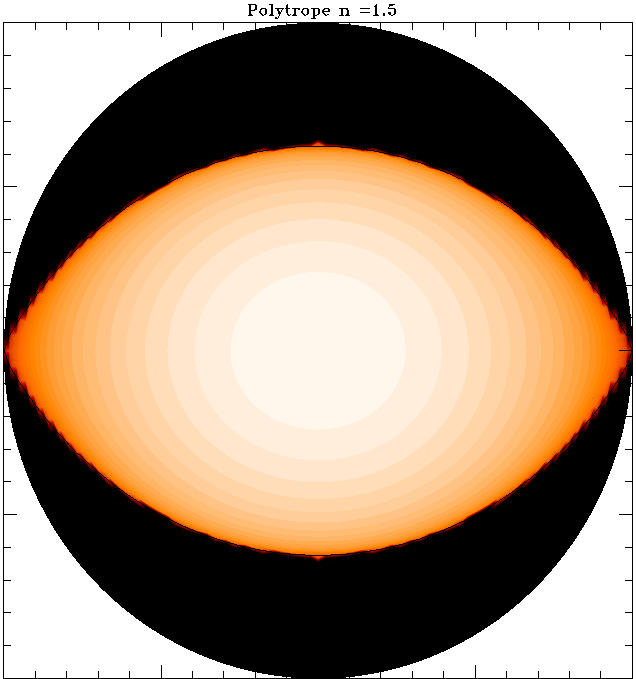
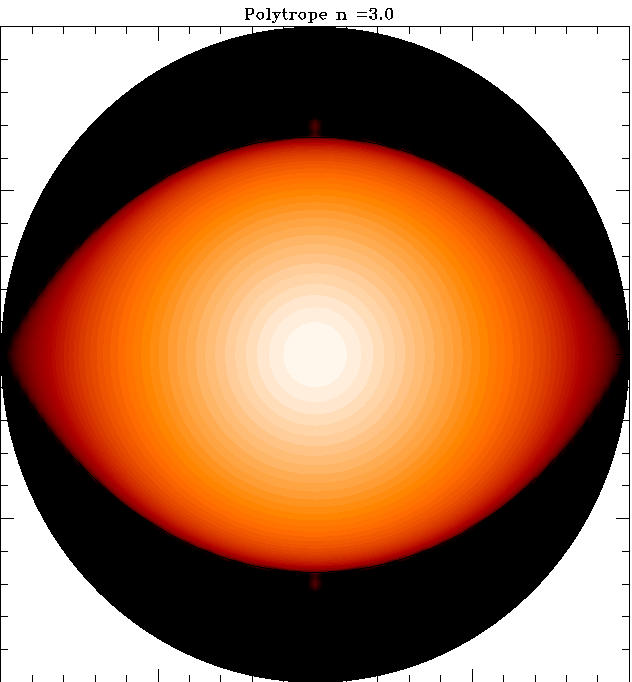
| | |
| A representation of the discretization grid: the star is shaded and split into
several layers; the outer white region is an outer vacuum domain where only the gravitational potential is computed.
| The shape of a n=3/2 polytrope rotating close to the break-up velocity.
| The same for a n=3 polytrope; note that as this polytrope is more
centrally condensed, its inner regions are less flattened.
|
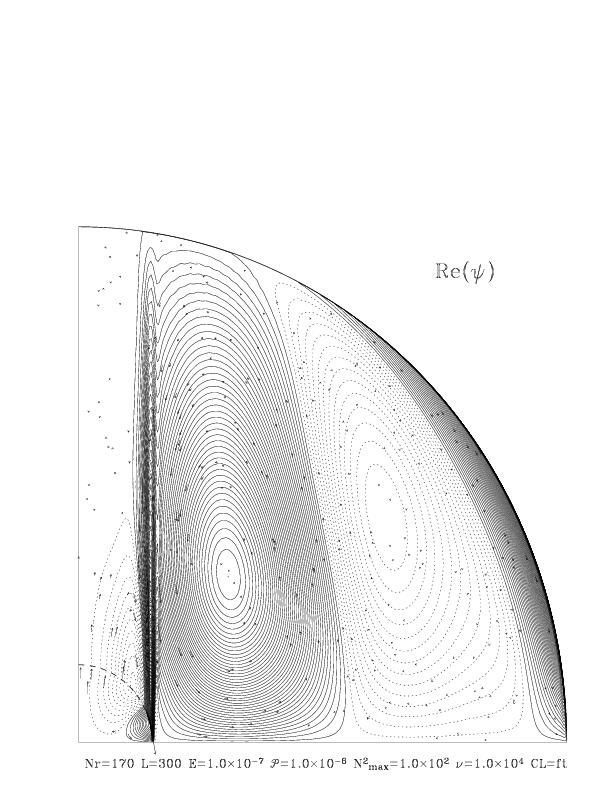
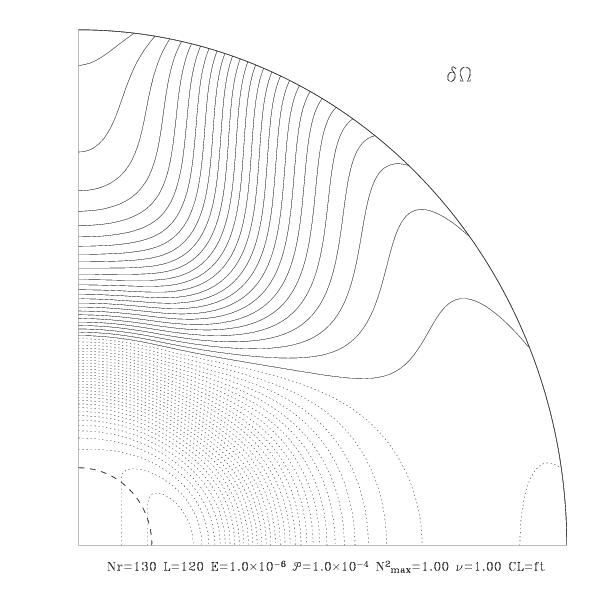
| |
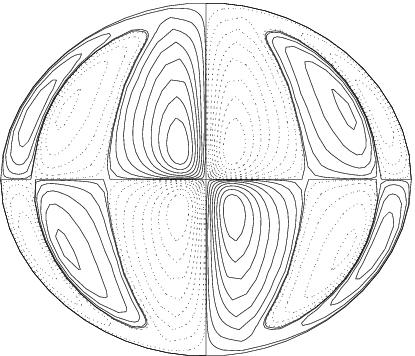
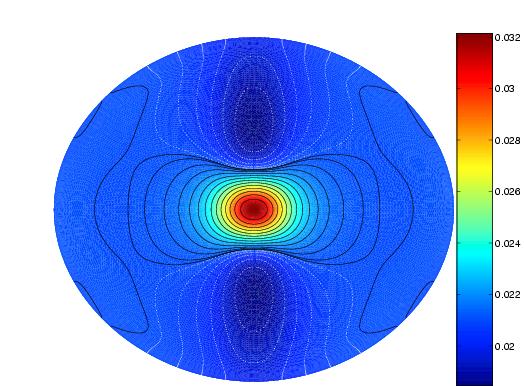
| |
| On the top row we see the meridional circulation and differential rotation
as predicted by a simplified Boussinesq model of a massive star (see Rieutord
2006 for details). In the bottom row we show the computed differential rotation
of a purely radiative star, with realistic physics (see Espinosa Lara and
Rieutord 2007).
|


| |
| Left: Differential rotation in a 5 solar mass star rotating at
70% of the critical angular velocity. Abundances are solar. Note the
similarity with the fully radiative star. Inside the convective the
rotation is cylindrical (more details in Rieutord and Espinosa Lara
2012). Right: The associated meridian circulations. The cells attached
to the convective core are the trace of the Stewartson layers when no
viscosity is present in the bulk of the fluid and at finite numerical
resolution. Spatial resolution: 400 Chebyshev polynomials+64
spherical harmonics.
|
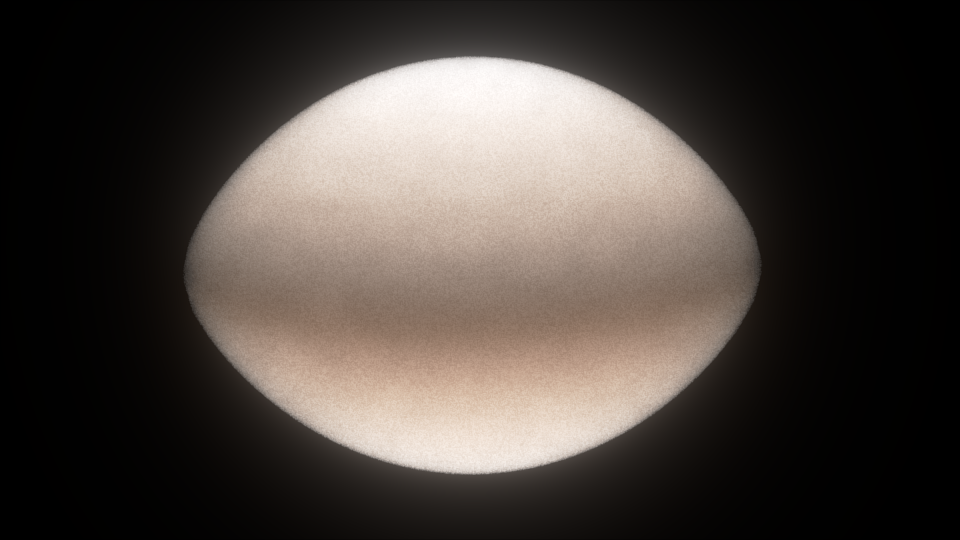
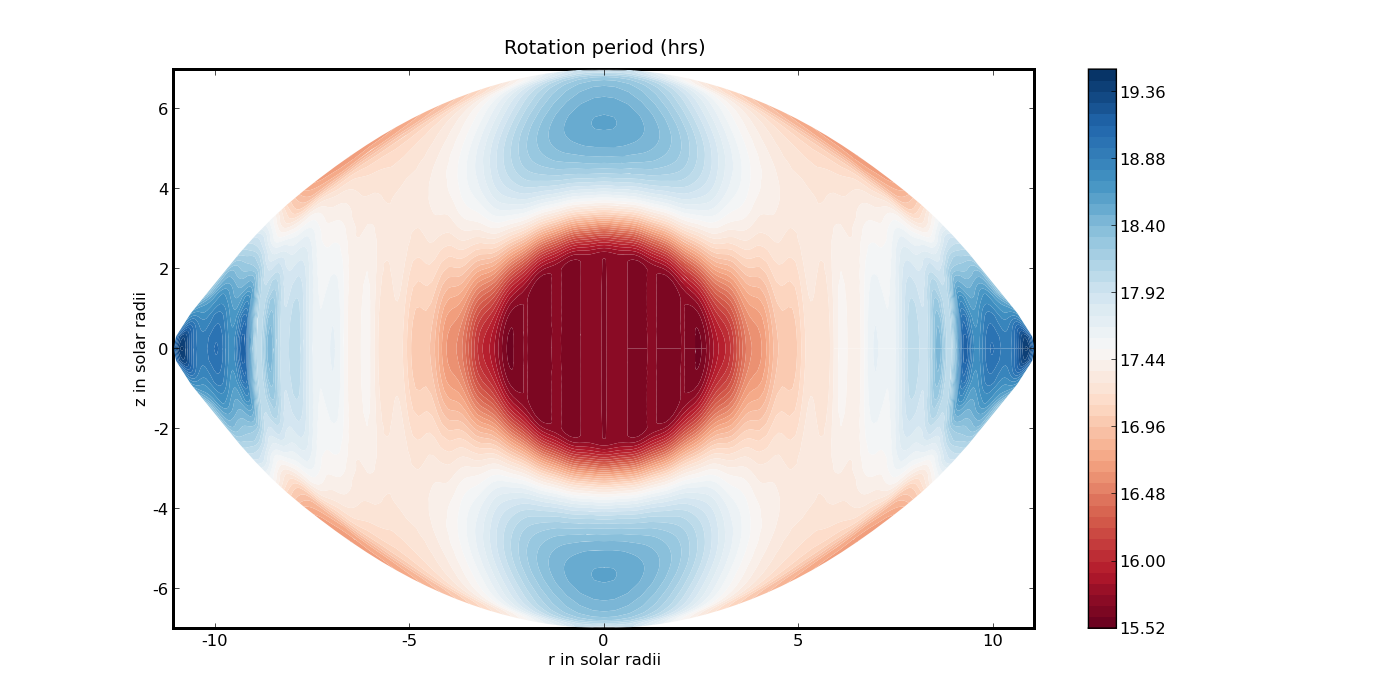
| |
| Left: Gravity darkening for an intermediate mass star
rotating at 90% of the critical angular velocity. Abundances are solar.
Right: The differential rotation of a 30 solar mass ZAMS star rotating
at 98% of the critical angular velocity. The ratio of equatorial radius
to polar radius is 1.56. |
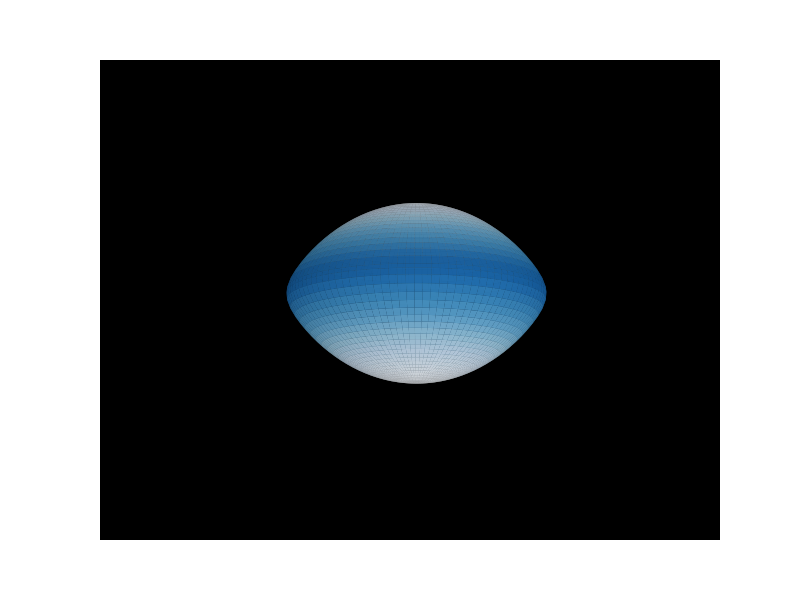
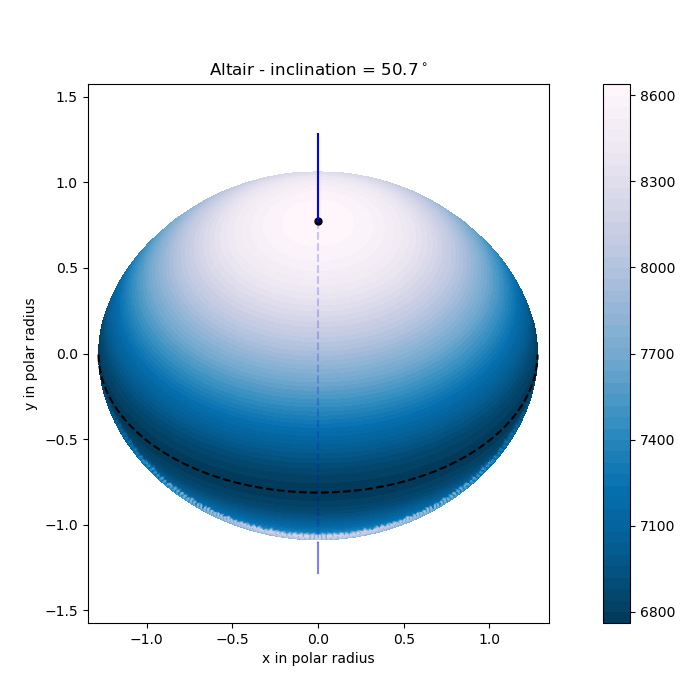
| |
| Left: The Be star (around 6 solar mass) Achernar modelled by ESTER
as it is viewed in the sky. Right: The flux at the surface of Altair as
given by the concordance model of Bouchaud et al. (2020).
|
More to come soon ...












